Iraq Currency Exchange Information
1990 - 2003
After the Gulf War in 1991, and due to the economic blockade, the previously used Swiss printing technology was no longer available. A new, inferior quality notes issue was produced. The previous issue became known as the Swiss dinar and continued to circulate in the Kurdish region of Iraq. Due to excessive government printing of the new notes issue, the dinar devalued quickly, and in late 1995, US$1 was valued at 3,000 dinars.
2003 - Today
Following the deposition of Saddam Hussein in the 2003 invasion of Iraq, the Iraqi Governing Council and the Office for Reconstruction and Humanitarian Assistance began printing more Saddam dinar notes as a stopgap measure to maintain the money supply until new currency could be introduced.
The Banking Law was issued September 19, 2003. The law brings Iraq's legal framework for banking in line with international standards, and seeks to promote confidence in the banking system by establishing a safe, sound, competitive and accessible banking system.
Between October 15, 2003 and January 15, 2004, the Coalition Provisional Authority issued new Iraqi dinar coins and notes, with the notes printed using modern anti-forgery techniques, to "create a single unified currency that is used throughout all of Iraq and will also make money more convenient to use in people's everyday lives. Old banknotes were exchanged for new at a one-to-one rate, except for the Swiss dinars, which were exchanged at a rate of 150 new dinars for one Swiss dinar.
The Central Bank of Iraq was established as Iraq's independent central bank by the Central Bank of Iraq Law of March 6, 2004
For the latest Currecny Auction Information, please visit the Currency Auctions Page on the
Central Bank Of Iraq web site.
Iraq Currency Photos
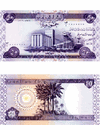
50 Dinars
FRONT:The grain silo at Basrah. Working at full capacity the facility can off-load and process 60,000 tonnes of grain per hour.
BACK: Date palms. Iraq used to be the world's largest producer and exporter of dates. Over 600 varieties are grown in-country.
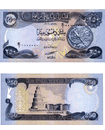
250 Dinars
FRONT:The astrolabe. One of the earliest scientific instruments - able to measure the time of day or night and altitude and latitude - conceived by the Greeks it was further developed by medieval Arab astronomers, who used it to help determine the time for fasting during the month of Ramadan.
BACK: The Spiral Minaret in Samarra, built 848-849 A.D. Samarra was then the Abbasid Empire's capital city.
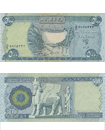
500 Dinars
FRONT: Ducan Dam: The dam is located by Al Zab dowside river within Sulaimania governorate ,it is 70 KM far to the north west of Sulaimania city.Dam Type: A bowed concrete , it half diameter is 120 M , it is top length 360 M . at a width of 8.4 M . Overall Storage Capacity : 6.8 Billion cubic meter
BACK: Winged Bull : It is a huge statue ,its length 4.42 M weighs more than 10 tons , one individual of the couples guards one of the wall doors of the dur shrokeen city which was founded by the Assyrian king Surjoon the second (721- 705 B.C.) which sinhareb , surjoon's son has abandoned and transferred the Capital to Ninava city.
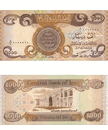
1,000 Dinars
FRONT:A gold dinar coin, used in this region until superseded by more modern coins and notes.
BACK: Al-Mustansirya University, Baghdad. Built in the mid-thirteenth century it was the most prominent university in the Islamic world in the Middle Ages.
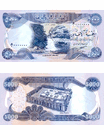
5,000 Dinars
FRONT: Gully Ali Beg and its 800m waterfall. The 10km gully passes between Mount Kork and Mount Nwathnin, some 60km away from Shaqlawa.
BACK: The second century desert fortress of Al-Ukhether
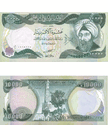
10,000 Dinars
FRONT:Abu Ali Hasan Ibn al-Haitham (known as Alhazen to medieval scholars in the West), born Basrah in 965 A.D. His most important work - although he wrote some 200 books - is held to be a seven volume series on optics Kitab al-Manazir, in which he gives the first correct explanation of vision, showing that light is reflected from an object into the eye. He is said to have "invented" the camera obscura.
BACK: Hadba Minaret, at the Great Nurid Mosque, Mosul, built 1172 A.D by Nurridin Zangi, the then Turkish ruler. The 59m-high minaret leans 8 feet off the perpendicular. That is how it earned its Arabic name Al-Hadba ("the humped")
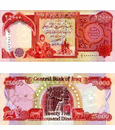
25,000 Dinars
FRONT: Kurdish farmer holding sheaf of wheat. Tractor in background.
BACK:King Hammurabi. Credited with writing the first code of law in human history he founded the First Dynasty of Babylon in 1700 BC, leading Babylonia into a period of great prosperity.
Archived Information For Research: Iraq Currency Exchange
Starting on October 15th 2003 a new national currency known as the "new Iraqi dinar" will begin to replace the existing currency, the "old dinar", and the currency used in the North of Iraq, the "swiss dinar". The new Iraqi dinar will create a single unified currency that is used throughout all of Iraq and will also make money more convenient to use in people"s everyday lives.
The currency exchange will last from October 15th 2003 to January 15th 2004. Currency can be exchanged at any time during this three month period. Locations where money can be exchanged will include banks and other official locations, for example post offices, throughout Iraq. No fees will be charged for exchanging currency.
The conversion rates for new Iraqi dinars will be as follows:
one "old dinar" will be exchanged for one new Iraqi dinar;
one unit of the "swiss" dinar will be exchanged for 150 new Iraqi dinars.
Bank accounts and financial contracts in Swiss dinars will also be converted at the rate of 150 new Iraqi dinars for every one Swiss dinar. Bank accounts and contracts in old Iraqi dinar will not change.
The new currency will have a larger number of denominations than the old currency, with 50, 250, 1000, 5000, 10000 and 25,000 dinar notes, making it more convenient to use. The new notes will be of higher quality and durability than those currently in circulation and include many anti-fraud features that will provide important protection against counterfeiting.
How will the exchange occur?
(1) People will come to banks with their currency
(2) Currency will be counted and its equivalent value in new currency will be paid
(3) Old currency will be promptly marked and will then be destroyed
(4) Those with bank accounts will see their balances automatically converted. Salaries will begin to be paid in the new dinar at the earliest available opportunity.
Currently everyone in Iraq carries a reminder of Saddam in their pockets and on the banknotes they"re using. Shortly after October 15th the first batch of Saddam notes will go to the incinerator. At close of business January 15th 2004 Saddam notes will no longer be legal tender.
Below are some answers to frequently asked questions:
Q:What will the new currency look like?
A:The new Iraqi dinar will look similar to Iraq"s old national dinar (the "Swiss" dinar), with some minor modifications
Q:What will be the rate that is used to convert old currency into new currency?
A:People who hold one old Iraqi dinar will receive one new Iraqi dinar. People who have one "Swiss" dinar will receive 150 new Iraqi dinars.
Q:Why were these rates selected?
A:These rates will help to equalize prices throughout all of Iraq by helping to ensure that the prices of goods will be roughly the same across the whole country. Key Iraqis, including officials at the Iraqi Central Bank as well as leaders of the autonomous regions in northern Iraq, were consulted on this issue and fully supported this decision.
Q:How will the new currency differ from the existing currency?
A:The new currency will have a total of six denominations, will be much better protected against counterfeiting, and will last much longer because it will be of higher quality.
Q:Will people need to exchange their currency immediately?
A:No. Currency can be exchanged at any time up until January 15th.
Q:Will the old Iraqi dinar and the Swiss dinar continue to be valid until January 15th?
A:Yes. All existing currency will be completely valid until Janaury 15.
Q:Will salaries be paid in new dinars?
A:Yes. After the exchange has begun, salaries will begin to be paid in new Iraqi dinars.
Q:How will people be able to identify counterfeit currency?
A:As the exchange approaches additional details will be provided about how to identify counterfeit notes. Staff at currency exchange sites will also be well trained on how to detect counterfeit Iraqi dinars. Counterfeit old Iraqi dinars will not be accepted at the exchange sites. Those presenting counterfeit notes will not be arrested or charged with a crime, but their money will not be exchanged. Currency exchange sites will visibly mark old dinars upon their exchange for new ones so that they cannot be stolen and re-exchanged later. Once the old currency is marked it will no longer be valid currency.
Q:Will the new currency be convertible into other currencies?
A:Yes. The new currency will be convertible into other currencies at the market exchange rate that prevails at that time.
Q:Can dollars also be exchanged for new Iraqi dinars" What will be the conversion rate for dollars?
A:Dollars will not be converted directly into new dinars during the official exchange. Following the exchange, dollars will be convertible directly into new dinars at the market exchange rate. New dinars will also be convertible into dollars as well as other currencies at the market exchange rate.
Q:Will it be possible to exchange currency outside of Iraq?
A:No. The only official currency exchange locations will be located within Iraq.

1. Lainey (12/01/10 00:59:02 US EST)
China and Russia announced Wed they'll no longer trade with each other utilizing the United States $. China-Russia dollar move may signal end to manipulation of yuan. The announcement came as top officials from China and Russia met in St. Petersburg to forge bilateral cooperation in trade and energy. The China-Russia dollar decision is not seen as detrimental to United States currency and could force the value of the yuan in line with other global currencies.